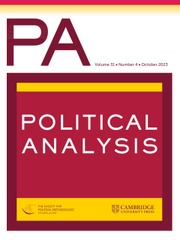Crossref Citations
This article has been cited by the following publications. This list is generated based on data provided by
Crossref.
Herrmann, Michael
Munzert, Simon
and
Selb, Peter
2012.
How Strategic Votes Matter.
SSRN Electronic Journal,
Hanretty, Chris
Lauderdale, Benjamin E.
and
Vivyan, Nick
2012.
Dyadic Representation in a Westminster System.
SSRN Electronic Journal,
Buttice, Matthew K.
and
Highton, Benjamin
2013.
How Does Multilevel Regression and Poststratification Perform with Conventional National Surveys?.
Political Analysis,
Vol. 21,
Issue. 4,
p.
449.
Debus, Marc
and
Bäck, Hanna
2014.
Der Einfluss von Mandatstyp und Wahlkreiseigenschaften auf die inhaltlichen Positionen in Parlamentsreden: Eine Untersuchung anhand der parlamentarischen Debatten im Deutschen Bundestag von 1998 bis 2002.
Swiss Political Science Review,
Vol. 20,
Issue. 2,
p.
330.
Bernauer, Julian
and
Munzert, Simon
2014.
LOYAL TO THE GAME? STRATEGIC POLICY REPRESENTATION IN MIXED ELECTORAL SYSTEMS.
Representation,
Vol. 50,
Issue. 1,
p.
83.
Baumann, Markus
Debus, Marc
and
Müller, Jochen
2015.
Personal Characteristics of MPs and Legislative Behavior in Moral Policymaking.
Legislative Studies Quarterly,
Vol. 40,
Issue. 2,
p.
179.
Claassen, Christopher
2016.
Improving and Validating Survey Estimates of Religious Demography Using Bayesian Multilevel Models and Poststratification.
SSRN Electronic Journal ,
Herrmann, Michael
Munzert, Simon
and
Selb, Peter
2016.
Determining the Effect of Strategic Voting on Election Results.
Journal of the Royal Statistical Society Series A: Statistics in Society,
Vol. 179,
Issue. 2,
p.
583.
Leemann, Lucas
and
Wasserfallen, Fabio
2017.
Extending the Use and Prediction Precision of Subnational Public Opinion Estimation.
American Journal of Political Science,
Vol. 61,
Issue. 4,
p.
1003.
Hanretty, Chris
Lauderdale, Benjamin E.
and
Vivyan, Nick
2017.
Dyadic Representation in a Westminster System.
Legislative Studies Quarterly,
Vol. 42,
Issue. 2,
p.
235.
Munzert, Simon
2017.
Forecasting elections at the constituency level: A correction–combination procedure.
International Journal of Forecasting,
Vol. 33,
Issue. 2,
p.
467.
Hanretty, Chris
Lauderdale, Benjamin E.
and
Vivyan, Nick
2018.
Comparing Strategies for Estimating Constituency Opinion from National Survey Samples.
Political Science Research and Methods,
Vol. 6,
Issue. 3,
p.
571.
LAX, JEFFREY R.
PHILLIPS, JUSTIN H.
and
ZELIZER, ADAM
2019.
The Party or the Purse? Unequal Representation in the US Senate.
American Political Science Review,
Vol. 113,
Issue. 4,
p.
917.
Caughey, Devin
and
Warshaw, Christopher
2019.
Public Opinion in Subnational Politics.
The Journal of Politics,
Vol. 81,
Issue. 1,
p.
352.
Downes, Marnie
and
Carlin, John B.
2020.
Multilevel regression and poststratification as a modeling approach for estimating population quantities in large population health studies: A simulation study.
Biometrical Journal,
Vol. 62,
Issue. 2,
p.
479.
Valliant, Richard
2020.
Comparing Alternatives for Estimation from Nonprobability Samples.
Journal of Survey Statistics and Methodology,
Vol. 8,
Issue. 2,
p.
231.
Hanretty, Chris
2020.
An Introduction to Multilevel Regression and Post-Stratification for Estimating Constituency Opinion.
Political Studies Review,
Vol. 18,
Issue. 4,
p.
630.
Claassen, Christopher
and
Traunmüller, Richard
2020.
Improving and Validating Survey Estimates of Religious Demography Using Bayesian Multilevel Models and Poststratification.
Sociological Methods & Research,
Vol. 49,
Issue. 3,
p.
603.
Lauderdale, Benjamin E.
Bailey, Delia
Blumenau, Jack
and
Rivers, Douglas
2020.
Model-based pre-election polling for national and sub-national outcomes in the US and UK.
International Journal of Forecasting,
Vol. 36,
Issue. 2,
p.
399.
Hoover, Joe
Atari, Mohammad
Mostafazadeh Davani, Aida
Kennedy, Brendan
Portillo-Wightman, Gwenyth
Yeh, Leigh
and
Dehghani, Morteza
2021.
Investigating the role of group-based morality in extreme behavioral expressions of prejudice.
Nature Communications,
Vol. 12,
Issue. 1,


